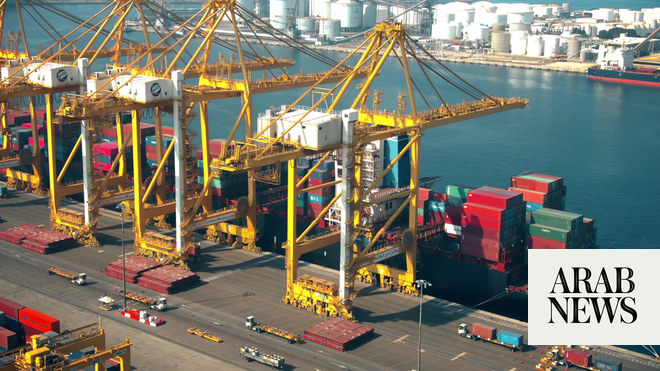
RIYADH: International economic growth showed resilience in June, maintaining the second-highest level observed in the past 13 months, according to S&P Global’s latest report based on the Purchasing Managers’ Index.
The JP Morgan global composite PMI, compiled by S&P Global, edged down to 52.9 in June from 53.7 in May. This slight decrease reflects a slowdown in the expansion rates of manufacturing production and service sector business activities worldwide.
Amidst this global trend, Saudi Arabia’s non-oil private sector PMI stayed strong at 55 in June, fueled by rising demand, increased output levels, and a notable uptick in employment.
A PMI reading above 50 signifies economic expansion, while below 50 indicates contraction. It measures economic trends in manufacturing based on monthly surveys of supply chain managers covering upstream and downstream activities.
“The global all-industry output PMI stepped back 0.8 percentage points to 52.9 in June, with the decline fairly broad-based across sectors and regions. Although suggesting some momentum loss at midyear, the index is still consistent with a solid pace of expansion in global gross domestic product,” said Bennett Parrish, global economist at JP Morgan.
He added: “Declines in the new orders and future output PMIs may raise the risk of growth moderating further, but another move up in the employment PMI suggests that underlying fundamentals remain resilient.”
US and India growth accelerates
The report highlighted accelerated PMI growth rates in the US, India, and Brazil. In the US, output expanded at the fastest pace since April 2022, driven by robust services activity which offset subdued manufacturing growth.
India led the BRIC economies with strong growth momentum recovering from an election-related dip in May, marking one of its strongest performances in 14 years across goods and services sectors.
Similarly, Brazil sustained strong expansion throughout the year with both service and manufacturing sectors contributing positively after a near-stalled growth in May.
“June saw a further slight acceleration of growth in the US, bucking a broader developed world slowdown, while India continued to lead the emerging markets by a wide margin,” said Chris Williamson, chief business economist at S&P Global Market Intelligence.
In contrast, output fell in Canada, having risen briefly in May for the first time in a year, led by a weakened service sector.
“Japan also slipped back into decline. Although only marginal, the downturn was the first recorded for seven months. A first fall in services sector output for 22 months was partly countered by a rise in manufacturing output for the first time in 13 months,” added Williamson.
Russia reported a slight output contraction, marking its first decline in 17 months as a significant drop in services activity countered resilient manufacturing growth.
Growth also slowed in China, albeit merely paying back some of the substantial gains witnessed in May to still register one of the strongest expansions over the past year. However, robust growth in the Asian giant’s manufacturing sector helped counter a marked slowing in services activities in June.
Meanwhile, the UK reported an eighth successive monthly expansion. However, growth slowed in manufacturing and services to result in the weakest upturn this year, albeit partly blamed on a pause in spending ahead of the upcoming election, S&P Global added.
Global sub-sectors stable
The US-based firm noted that growth became more broad-based across all global sub-sectors amidst the slowing of expansion.
“All of the 25 sub-sectors covered by the PMI avoided contraction globally in June for the first time since July 2021. Expansions were reported across the board bar general industrials, which reported stable output,” said Williamson.
The report noted that output rose at the quickest pace in the financial services category, while solid expansions were also seen in the business services, consumer goods and intermediate goods sectors.
However, the rate of expansion was relatively mild in the consumer services sector.
“Other noteworthy developments include a two-year high for chemicals and plastics output and a 28-month high for forestry and paper products, while the autos and parts sector rounded off its best quarter since early 2021,” the analysis added.
Global employment increased for the second consecutive month in June, with the pace of job growth reaching its highest in a year across both manufacturing and service sectors.
“Stronger increases in staffing levels were initiated in both the manufacturing and service sectors, with the sharper increase again registered in the latter. Of the nations covered by the survey, only China and Germany saw reductions in staffing levels,” said S&P Global.
Future outlook
Looking ahead, S&P Global warned of darkening near-term global prospects in June, with business expectations for the year ahead reaching a seven-month low, particularly affected by post-election uncertainties in India and Europe, including the UK and France.
“However, sentiment was also pulled lower by concern over the demand environment going forward, as reflected in a pull-back in new orders growth from May’s one-year high, which left backlogs of work largely unchanged again during the month. The latter is typically a sign of current capacity being sufficient to meet existing demand,” the agency concluded.












